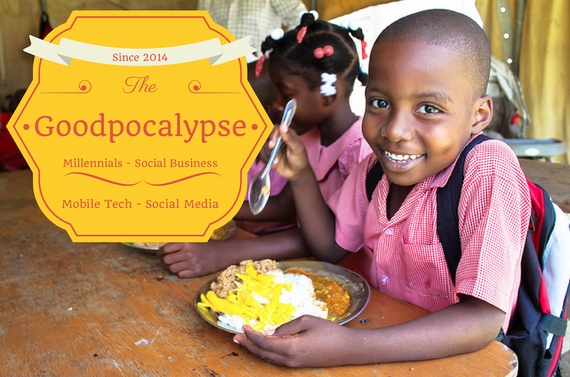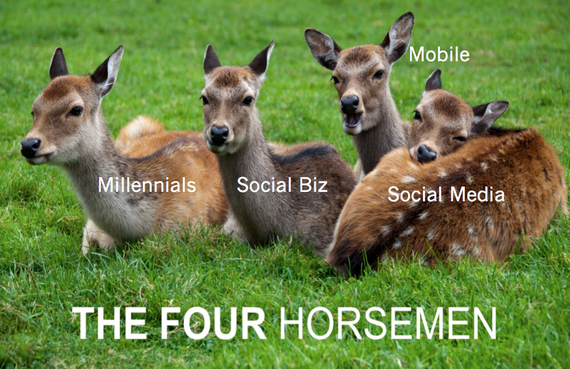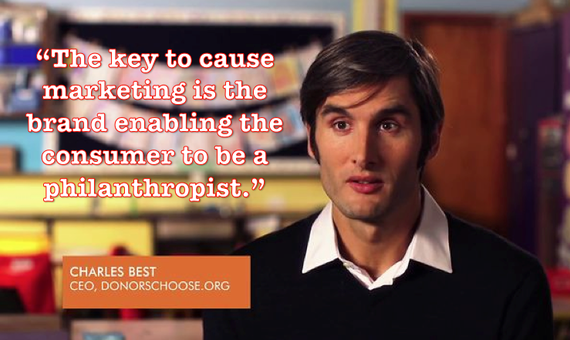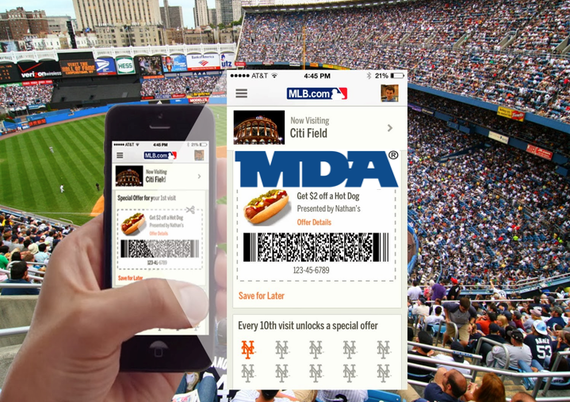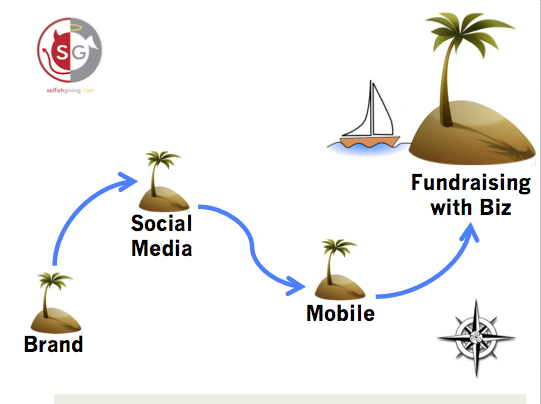Millennials, social business and media and mobile are converging to create a golden age of good. Here's how nonprofits can thrive in a world turned right-side up.
I'm kind of bummed that there won't be a zombie apocalypse anytime soon. I've watched so many shows and movies about zombies that I'm sure I know enough to survive in a world turned upside down. What I'm unsure of is if I'll ever get a chance to outrun a zombie, or to relish my stockpiles of food and supplies. Sigh.
I realized all this one night when I was watching my favorite TV show The Walking Dead. Amidst all the violence, despair and feeding zombies, I thought: "There's no zombie apocalypse coming. The future will be more good than bad. It will be a....Goodpocalypse."
I'm not trying to be cute, or making this up. When it comes to cause marketing I'm always looking for what's next for the field. Instead, I stumbled on what's next for humankind: a golden age of good.
The Four Horsemen of the Goodpocalypse
The four horsemen of the Goodpocalypse are Millennials, social business, mobile technology and social media.
MILLENNIALS
Millennials - men and women ages 18 to 34 - may be the most socially conscious generation in American history. They expect companies - and nonprofits - to meet their high standards with responsible and impactful programs.
For companies that heed the call of Millennials, the benefits are clear. According to the Cone Millennial Cause Study, after learning that a company is socially and/or environmentally responsible:
- 83% of Millennials are likely to trust the company more
- 79% are likely to purchase that company's products
- 44% are likely to actively pursue working at that company
- 74% are more likely to pay attention to that company's message because it has a deep commitment to a cause
Organizations that ignore this generation, and its commitment to social causes, do so at their own peril.
Earlier this year, lower-than-expected earnings for warehouse club Costco raised concerns its customer base doesn't include enough Millennial shoppers. Costco and other organizations cannot survive without the largest generation - 80 million people strong. Another victim is golf. Millennials playing golf fell 13 percent over the past five years, a major miss for the sport.
Golf for a cause, anyone?
Millennials are natural do-gooders, but they are not alone. A global survey by Edelman showed that 87% of human beings believe businesses should place at least equal weight on profit and purpose.
Baby Boomers and Gen Xers (and the to-be-named generation that was born after 2000) are not far behind Millennials in their commitment to supporting causes and driving social change.
SOCIAL BUSINESS
What social problem is your company trying to solve? It's a question every business has to answer, as every organization will one day be a social organization. Companies will be as deeply committed to social change as they are to turning a profit. Consumers - no, the people of the planet! - will demand this of businesses.
Kellogg's, for example, is committed to hunger relief. Through its Breakfasts for Better Days initiative, the company will donate one billion servings of cereal and snacks in support of global hunger relief by the end of 2016.
Yes, companies will play a major role in solving social problems, but these gains won't be accomplished with the corporate checkbook. U. S. companies donate $16 billion to charitable causes each year. This seems impressive, but individuals contribute several hundred billion dollars to causes each year.
As Charles Best, the CEO of Donorschoose.org has said: "The key to cause marketing is the brand enabling the consumer to be a philanthropist." The money needed to address social problems isn't in the company. It's in the consumers and employees to which businesses have unequaled access.
Kmart - by all accounts a struggling retailer with an uncertain future - raised $22 million for St. Jude Children's Research Hospital. In a post earlier this year, I asked, "How the hell did Kmart raise so much money?!"
Brian Hanover, Directior of Public Relations at Sears (Sears owns Kmart), answered me and pointed to the harnessed power of business, technology and stakeholders.
We can tell you that St. Jude is a cause that clearly resonates with our Kmart Shop Your Way members and customers, and millions of them embraced the campaign like never before. In addition, Kmart associates were as dedicated as ever, consistently reminding and educating our shoppers about the campaign.
Further, we're always looking to streamline our process to better serve our members. This year we upgraded our check-out technology to make it even easier and faster for customers to make a donation at the register.
All told, it's a great example of how small changes and small acts by many people working together toward a wonderful goal can yield amazing results.
But social responsibility isn't just about raising more money for causes. It's about companies looking at every part of their business operation for opportunities to be more sustainable and responsible. These changes will come in all shapes and sizes.
Britain's Marks & Spencer stores, offices, delivery fleets and warehouses in the UK and Ireland are now carbon-neutral. Overall, M&S' CO2 emissions are down 23 percent since they launched the effort in 2007.
General Motors discovered an opportunity in its trash. To support the Empowerment Plan, a Detroit-based organization that employs homeless women to make coats for the needy, GM donated scrap sound-absorption material from its cars to be used as insulation for the coats.
I can't predict the future, but I can tell you this: more companies will be like Tom's Shoes, Warby Parker and Chipotle than not. Millennials have raised the bar for businesses. But this will be one bar that no one will get to go under.
MOBILE
Mobile is the future of, well, everything, and that includes fundraising with businesses. The future of fundraising is targeting donors where they are and where they care. New technologies like iBeacon are showing how this is now a reality.
iBeacon is "micro-location" in that it works in a physical location (like a store) and business apps installed on your smartphone. An iBeacon transmitter businesses can better interact with smartphone-toting consumers in and or near a business. Sure, they can push coupons to them when they walk in the door, but they can also give them one when they linger in a particular aisle or over a specific product.
Companies can even push reminders to consumers. "Last time you were on our website you were searching for a blend of coffee that we have in stock."
Think about the possibilities for cause marketing. Companies can tell them which causes they are supporting, which products are eligible for a donation and even ask you to donate while you stand in the checkout line.
Another cool thing about iBeacon is that it turns consumers into beacons. When you support a cause at the register the business can update others in the store of the new grand total raised for its favorite charity, which will encourage consumers to give when it's their turn at the register.
iBeacon may sound incredible, but it's really just the beginning. We're quickly moving to a truly "wired world" where everything will be connected to the internet. Perhaps like you I thought the web was the internet. But the web is just one way of connecting to the internet, which is actually a massive network of networks. (I know, who knew!)
Everything will be connected to the internet. Cities, cars, buildings, for sure. But also toothbrushes, blenders and, yes, even your dog.
A product called TAGG attaches to your dog's collar and you get an email or text when your pooch strays outside your yard. Of course, GPS and a companion app for your smart phone will show your dog's exact location.
Think about the potential for good. A tag that keeps track of your dog means fewer chances for mischief and unwanted offspring. That's a good thing, right? And because TAGG is a supporter of the ASPCA, you get smart phone alerts on cute dogs at nearby shelters. Also, because TAGG allows you to define the area your dog stays in, you can make a donation to ASPCA every time your dog strays outside the area -- or stays in it!
We currently have around 20 billion things connected to the internet. This could jump to 80 billion or more over the next five years. That's ten connected items for every man, woman, and child on the planet!
This means things as common as a dog collar, washing machine, and refrigerator will be deeply connected to our smart phones and lives -- not to mention our cause-related goals and interests.
Yes, the "Good" refrigerator is coming -- and so much more. This Internet of Things will be an Internet of Good Things, too.
While it's easier to discuss Millennials, social business and mobile technology separately, don't forget their interconnectedness.
Millennials are demanding do-gooders that expect others to follow suit. If you do or don't, they'll be sure to let their friends know via mobile devices and social networks.
Social businesses are keeping pace with the largest generation in history by adopting their causes, technology and communications.
Mobile devices are the remote control people's lives. We'll do everything though our smartphones, tablets, Google Glasses, smart watches, etc. Mobile has made causes portable, and nonprofits need to rethink how they communicate and fundraise from a donor that is always engaged and tremendously influential.
SOCIAL MEDIA
If social impact is the fire, social media is the gasoline
According to a recent social influence research paper from Crowdtap, Millennials spend almost 30% (or five hours a day) of their time on content created by family, friends and others they know. They also prioritize social networking above all other media types, with 71% saying they engage in social media daily.
Of course, nearly all of this social media activity happens on mobile devices, which Millennials use more than any other generation. Four of five use a smartphone compared to just over two of three 35-54 year olds and two of five 55+ year olds.
To connect with Millennials on social issues, businesses need to look beyond traditional advertising, which Millennials consume irregularly and is not influential. Social networks are where you can find Millennials and where you can earn their attention and trust.
In addition to being the current between Millennials, social businesss and mobile, social media is a nonprofit's best tool to communicate their impact and earn the attention of stakeholders.
Let me explain.
It starts with your brand.
Although we can define a brand as what people feel when they come into contact with your organization, a nonprofit brand is different than a for-profit brand. As Jeff Brooks has said, a nonprofit brand makes two promises:
- To have an impact
- To communicate that impact clearly and powerfully
The first priority for a nonprofit should be building its brand. And while most nonprofits are having an impact, they do a terrible job communicating that impact clearly and powerfully. This is why creating and publishing content is so critical to the success of your organization.
It's not like you have a choice. Using social media to share quality content about your organization isn't an option. Here's why.
Making the world a better place isn't enough anymore. If you're as old as I am, you may remember the days when there were only a handful of television stations to watch. These days, there are hundreds of stations to choose from, and the competition is brutal. It's the same with nonprofits. Charities such as the Salvation Army, American Red Cross, and St. Jude Children's Research Hospital were all lucky to establish their brands during simpler times.
Charities that have quickly succeeded in the past decade or so have been largely driven by celebrities, such as U2′s Bono for (RED) and Lance Armstrong for LIVESTRONG. For most of us, Oprah isn't calling. And, as we learned from the LIVESTRONG fallout, having a celebrity ambassador isn't all it's cracked up to be.
Instead, fall back on yourself and tell your own story with text, pictures, audio, infographics and video. Publishing interesting, useful, and credible content via social media is truly the rising tide that lifts all boats. The better you communicate your impact, the more your organization will become a magnet for all forms of giving. You'll raise more money from businesses, individuals, and foundations.
If you're like most nonprofits I know, you're stuck in the shallows with no current or wind. A powerful brand is having deep waters beneath you and a full sail on deck.
The wind that will lead you will be Millennials, social business and media and mobile technology. No, the zombies aren't coming, but they might as well be. You'll still have to save yourself.
The Goodpocalypse is near. Are you ready?
Joe Waters writes the web's leading cause marketing blog, Selfishgiving.com. He's the author of Fundraising with Businesses: 40 New (and Improved!) Strategies for Nonprofits.

